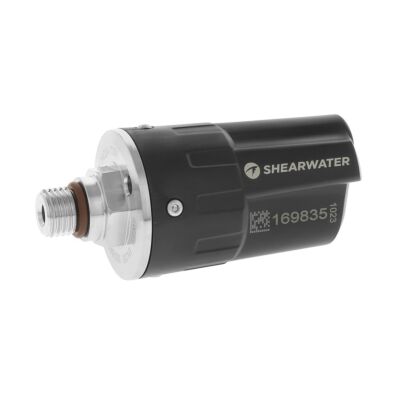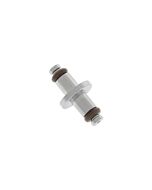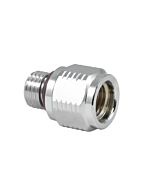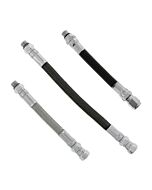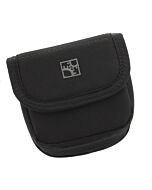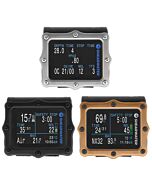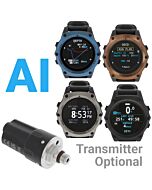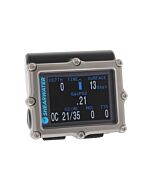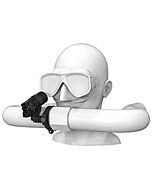Shearwater Research SWIFT Transmitter (MH-8A Compatible)
- Compatible with Shearwater Peregrine TX, Tern TX, Perdix-AI, Teric, Petrel 3, and NERD2 computer
- Also compatible with Apeks DSX computer
- Robust signal interference avoidance system
- Nitrox Ready, and rated for depth up to {650 ft | 200 m}
- Includes user replaceable CR2 photo battery
Shearwater Research SWIFT Transmitter (MH-8A Compatible)
The SWIFT tank pressure wireless transmitter is Nitrox Ready and compatible† with the current firmware release of those specific models of Shearwater Research brand dive computers that support hoseless air integration. This includes the Shearwater Tern TX, Perdix-AI, Perdix 2, Teric, Petrel 3, NERD 2 and the Peregrine TX model dive computers currently sold by Dive Gear Express, but does NOT include the Shearwater NERD 1, Petrel, Petrel 2, Peregrine (without the "TX"), Perdix (without the "AI"), or Tern (without the "TX"). A key feature of the SWIFT is an active interference avoidance system that allows multiple transmitters to work together.
The transmitter is oxygen compatible, rated for depth up to { 650 ft | 200 m } with tank pressure accuracy of ±5% full scale, and has a user replaceable and widely available CR2 photo battery. The battery life is approximately 300 dive hours or five years of storage. The Shearwater brand dive computers will display a low battery warning that indicates the transmitter number approximately 20 hours before the transmitter battery needs to be replaced. Each transmitter has its own unique ID and up to four transmitters can be linked to compatible Shearwater model dive computers. Shearwater has determined that as many as twenty SWIFT transmitters can operate in proximity to each other without signal interference.
The transmitter screws in to a high-pressure (HP) port of the first stage regulator mounted on the tank to be monitored. The transmitter uses the 38kHz radio frequency to signal data. An antenna inside the dive computer receives the RF data when it is positioned within { 72 in (6 ft) |1.8 m } of the transmitter and within a zone parallel or at a 45 degree angle to the transmitter. Best reception is achieved when the dive computer and transmitter are within { 3 ft | 0.9 m } of each other. The LED status indicator will flash green when a transmission is sent and flash red if an interfering signal is detected. During a dive you may at times move the dive computer so that is out of the signal pattern of the transmitter, resulting in a temporary interruption of the link. The link may also be interrupted if the dive computer is within { 3 ft | 0.9 m } of a running DPV or after a strobe light flashes. The link will be restored within 5 seconds after the dive computer is reoriented, moved back into range, or the RF noise clears. For technical diving, Dive Gear Express recommends following the best practice of also including a standard analog SPG on the regulator as a backup.
In rare cases, the body of some first stage regulator designs will have hose ports oriented such there is not room to accept a wireless tank pressure transmitter without interfering with hose routing. The solution is to use a standoff adapter, or some divers prefer to use a short HP hose pigtail (do not forget the required Air Spool) in place of the standoff.
† The SWIFT also works with those specific models of Aqualung, Apeks, Aeris, Hollis, Oceanic, Sherwood, and Tusa brand dive computers that support hose less air integration with PPS transmitters having the FCC ID = MH-8A number. This brings the same collision detection and avoidance benefits to those other brands of dive computers. The SWIFT transmitter is NOT compatible with any other brand dive computers.
| Brand | Shearwater Research |
|---|---|
| SKU | SRI-17001 |
| Weight | 0.450000 |
Customer Reviews
YOU MAY ALSO BE INTERESTED IN THE FOLLOWING PRODUCT(S)
About Gas Time Remaining (GTR) Calculations
Some dive computers have the ability to monitor a sensor that allows them to provide a digital display of the gas pressure in the dive cylinder. This feature is often referred to as 'air integration' (AI) but since nearly all modern dive computers are capable of handing a variety of breathing gases the term air is a misnomer. A few of the AI computers go a step further and use the tank pressure to calculate an estimate of the breathing gas time remaining (GTR). There are a variety of different methods and formulas for GTR calculations but they all share limitations such that, for specific divers and specific dives, the GTR displayed by your computer can be wildly inaccurate.
Just to be clear, the accuracy of the GTR is not a limitation of the computer or the transmitter but because there are simply too many unknowns to make the GTR anything other than a gross approximation. Beyond the obvious factors such as environment, depth variations in a multi-level dive profile, ascent rates, and stop times; the divers gas consumption rate will vary greatly depending on changes in equipment configuration and exertion. For this reason, GTR estimates are meaningless on most technical dives and even some deeper sport dives, particularly if hunting.
Another factor that can affect the GTR depends on the algorithm used for making the estimate. Some methods require the diver to know and enter an RMV consumption rate along with the volume of gas available (i.e. 'tank size'). Other methods use an observed SAC rate to develop a prediction based on consumption history and may optionally require the cylinder rated service pressure be entered. Computers that calculate GTR based on observed SAC rate history are particularly problematic when the diver uses different capacity cylinders on different dives.
While the GTR can be useful in warning inexperienced sport divers when gas consumption is abnormally high, Dive Gear Express does not recommend relying upon dive computer GTR estimates to control or extend the dive time. Never allow the computer GTR estimate to become part of your dive plan, always closely monitor your actual tank pressure.
